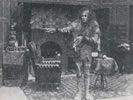Eye For Film >> Movies >> Frankenstein (1910) Film Review
Can what was once dead be made to live again? One of the first ever horror films and a massive success in its time, this Thomas Edison produced version of Mary Shelley's classic novel has been lovingly restored. It may not look great, but given its tortured history (early prints recycled for their silver content, the one surviving copy ripped up by a projector and reassembled by hand), it's doing impressively well. There's still lots to appreciate here beyond its status as a historical artefact.
Like many films of its time, this version of Frankenstein is shot with a static camera, framed like a stage play. However, director Dawley has a few tricks up his sleeve; the sets are well crafted and there's innovative use of doors and a mirror to expand our perspective. No effort has been spared in decorating the sets, so that we're thrust into the hero's world, location instantly established and full of character. This means the film is free to concentrate on action - vital given its short running time (and the expense involved in making it).

This action takes a few liberties with the original story but has plenty of respect for the evolving Frankenstein myth. It draws on other gothic novels including The Strange Case Of Dr Jekyll And Mr Hyde and The Picture Of Dorian Gray, emphasising the connection between the monster and his creator, who seem at times to be almost the same being. In other scenes there's a notable homoerotic undercurrent, with Frankenstein swooning onto a bed at the mercy of his creature, though of course there's a beautiful heroine (Mary Fuller) on hand to help him recover his traditional virtues.
Despite the poor quality of the print, Dawley's monster is on a par with many in modern horror films and must have seemed truly disturbing when the film was first released. Rather than being assembled from parts, he is created using a chemical process that sees him emerge as a skeleton gradually acquiring flesh. It's a haunting image which substantiates his unnaturalness. Unfortunate, then, that when fully developed he resembles a member of Lordi, but Charles Ogle still manages to make him seem threatening, looming impressively. Opposite him, Augustus Phillips is a master of grand gestures, making the hero a complex if somewhat effete individual, a man whom we can feel for even in this limited context.
This Frankenstein is not, in modern terms, very sophisticated, but it fills out its running time well and viewers are unlikely to lose patience with it. It might be considered the most successful adaptation in the terms of Shelley's original creature, who dreamed of begetting a new race of monsters.
Reviewed on: 09 Mar 2010



















